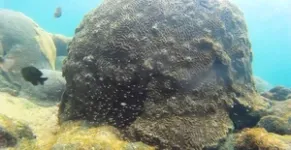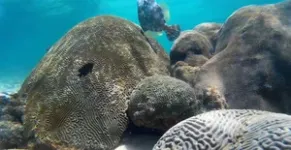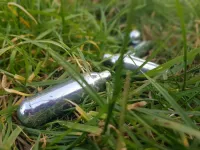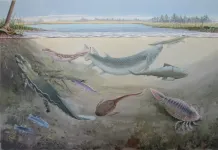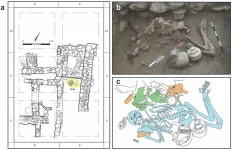(Press-News.org) A University of Texas at Arlington bioengineering professor is leading a state-funded project that will try to identify what T-cells are detecting in cancerous cells to better craft a personalized cancer immunotherapy.
George Alexandrakis received a $250,000 Cancer Prevention and Research Institute of Texas (CPRIT) grant titled “Ultrasensitive Nanosensor-Based Detection of Tumor Immunogenic Peptides to Enable Personalized Cancer Immunotherapy.”
“One of the challenges with cancer is that it is so variable. It changes all the time and is different in all people,” Alexandrakis said. “This research will use sensors we’ve developed to see what it is the T-cells are being attracted to when they decide to invade a tumor. The sensors are sniffing out what is there that the T-cells have noticed that activated them and made them ready to fight. This will enable us in the future to design a personalized, time-sensitive treatment.”
T-cells, which originate in the thymus, are white blood cells that are part of a person’s immune system. They help protect the body from infection and foreign particles, but can also attack cancer cells if they recognize them as foreign. A major current challenge is that cancer cells masquerade as healthy cells that belong where they are. Alexandrakis’ CPRIT-funded research will contribute to ongoing efforts focused on unmasking cancer cells and making them visible to a patient’s immune system.
This research is a continuation of the highly competitive National Institutes of Health R21 grant that Alexandrakis and Jon Weidanz, associate vice president for research and professor of kinesiology, started working on in 2020. Medical doctors in radiation oncology at UT Southwestern Medical Center are collaborating on the project.
Alexandrakis’ research project is the 13th from UT Arlington to receive CPRIT funding. He is one of 11 UTA professors to receive a CPRIT grant, and he also received one in 2012.
Michael Cho, chair of the UT Arlington Department of Bioengineering, said Alexandrakis’ project shows real promise for personalized medicine.
“This project can lay a foundation for immunotherapy that will work more specifically for an individual patient and would revolutionize cancer treatment as we know it,” Cho said.
Texans voted in 2007 to create CPRIT and invest $3 billion in the state’s fight against cancer. CPRIT is now a $6 billion, 20-year initiative—the largest state cancer research investment in the history of the United States and the second-largest cancer research and prevention program in the world. CPRIT has funded 1,819 awards for cancer research, product development and prevention since 2010. The total amount awarded thus far is nearly $3.2 billion.
CPRIT invests in the research at Texas universities and research organizations, creates and expands life science infrastructure across the state and expedites research innovation to help the potential breakthroughs in prevention and cures.
END
UTA research explores how T-cells detect cancer
CPRIT-funded research aims to develop personalized immunotherapy treatment
2023-02-23
ELSE PRESS RELEASES FROM THIS DATE:
After 25 years of AI health tech research computers are slowly beginning to listen to patients
2023-02-23
Patients experiences of health conditions are slowly being integrated into healthcare AI studies, a review of 25 years of studies has found.
In a new paper published in Lancet Digital Health along with an associated opinion piece, experts from the University of Birmingham and University Hospitals Birmingham have looked at more than 600 interventional studies on AI healthcare technologies.
While the team, funded by the National Institute for Health and Care Research (NIHR), found that only 24% of studies have a patient reported outcome element included in their study, there has been an increase in the number in recent years with 2021 and 2022 seeing nearly two thirds of all studies ...
Prioritise tackling toxic emissions from tyres, urge Imperial experts
2023-02-23
Imperial experts are calling for more to be done to limit the potentially harmful impact of toxic tyre particles on health and the environment.
The researchers, from Imperial College London’s Transition to Zero Pollution initiative, warn that even though electric vehicles remove the problem of fuel emissions, we will continue to have a problem with particulate matter because of tyre wear.
Six million tonnes of tyre wear particles are released globally each year, and in London alone, 2.6 million vehicles emit around nine thousand tonnes of tyre wear particles annually.
Despite this, research on the environmental ...
Surge in nitrous oxide abuse: New guidelines to help clinicians recognise cases and prevent spinal cord damage
2023-02-23
Recommendations from research published today on the diagnosis and treatment of spinal cord damage caused by nitrous oxide abuse have been simultaneously adopted as official clinical practice guidelines by the Association of British Neurologists. The unprecedented speed in translating research into practice is necessary as medical cases of nitrous oxide abuse surge in parallel with increased use of what is now the second most popular recreational drug among young people in the UK.
Recreational use of nitrous oxide (N2O - also known as laughing gas) ...
Technical adequacy of artificial intelligence body composition assessed in external CT
2023-02-23
Leesburg, VA, February 23, 2023—According to an accepted manuscript published in ARRS’ American Journal of Roentgenology (AJR), certain reasons for AI tool failure relating to technical factors may be largely preventable through proper acquisition and reconstruction protocols.
“The automated AI body composition tools had high technical adequacy rates in a heterogeneous sample of external CT examinations, supporting the tools’ generalizability and potential for broad use,” concluded head researcher B. Dustin Pooler, MD, from the University of ...
New predatory fish species which lived about 360 million years ago may have grown to over 2.5m long, according to analysis of South African fossils
2023-02-22
New predatory fish species which lived about 360 million years ago may have grown to over 2.5m long, according to analysis of South African fossils
###
Article URL: https://journals.plos.org/plosone/article?id=10.1371/journal.pone.0281333
Article Title: A high latitude Gondwanan species of the Late Devonian tristichopterid Hyneria (Osteichthyes: Sarcopterygii)
Author Countries: South Africa, Sweden
Funding: PEA: Wallenberg Scholarship (not numbered), from the Knut & Alice Wallenberg Foundation. https://kaw.wallenberg.org PEA: ERC Advanced ...
Influence of US weather conditions on tornado trends since 1980 explored by new model
2023-02-22
Influence of US weather conditions on tornado trends since 1980 explored by new model
###
Article URL: https://journals.plos.org/plosone/article?id=10.1371/journal.pone.0281312
Article Title: Long term temporal trends in synoptic-scale weather conditions favoring significant tornado occurrence over the central United States
Author Countries: USA
Funding: The authors received no specific funding for this work. END ...
Cash transfers in LMICs may help alleviate depression and anxiety symptoms - especially if such transfers are unconditional
2023-02-22
Cash transfers in LMICs may help alleviate depression and anxiety symptoms - especially if such transfers are unconditional
###
Article URL: https://journals.plos.org/plosone/article?id=10.1371/journal.pone.0281283
Article Title: Do cash transfers alleviate common mental disorders in low- and middle-income countries? A systematic review and meta-analysis
Author Countries: UK, Germany
Funding: JS was supported by the Joachim Herz Foundation (https://www.joachim-herz-stiftung.de/en/). AR received funding from the Wellcome Trust (220206/Z/20/Z, ...
Two high status brothers had access to “brain surgery” in Bronze Age Israel
2023-02-22
Two high status brothers buried in a Bronze Age tomb in Israel were severely ill but apparently had access to rare treatments including trephination, according to a study published February 22, 2023 in the open-access journal PLOS ONE by Rachel Kalisher of Brown University, Rhode Island, and colleagues.
In this study, authors examined the remains of two individuals buried in a tomb beneath an elite residence in the archaeological site of Tel Megiddo in Israel. The tomb dates to the Late Bronze Age (around 1550-1450 BC), and DNA testing suggests the buried individuals are brothers. Both skeletons show evidence of disease, providing an opportunity ...
Archaeologists uncover early evidence of brain surgery in Ancient Near East
2023-02-22
PROVIDENCE, R.I. [Brown University] — Archaeologists know that people have practiced cranial trephination, a medical procedure that involves cutting a hole in the skull, for thousands of years. They’ve turned up evidence that ancient civilizations across the globe, from South America to Africa and beyond, performed the surgery.
Now, thanks to a recent excavation at the ancient city of Megiddo, Israel, there’s new evidence that one particular type of trephination dates back to at least the late Bronze Age.
Rachel Kalisher, a Ph.D. candidate at Brown University’s Joukowsky ...
Keeping babies alive will lower population growth – new research
2023-02-22
Keeping babies alive will lower population growth – new research
New research showing high infant mortality rates are contributing to an incessant rise of the global human population supports arguments for greater access to contraception and family planning in low- and middle-income nations.
In an article published in PLOS ONE, research led by Professor Corey Bradshaw, Matthew Flinders Professor of Global Ecology from Flinders University and Peter Le Souëf, Professor of Paediatrics from The University of Western Australia has found that with higher baby death rates and larger household sizes (as an indicator of population density), ...
LAST 30 PRESS RELEASES:
Scalable and healable gradient textiles for multi‑scenario radiative cooling via bicomponent blow spinning
Research shows informed traders never let a good climate crisis go to waste
Intelligent XGBoost framework enhances asphalt pavement skid resistance assessment
Dual-function biomaterials for postoperative osteosarcoma: Tumor suppression and bone regeneration
New framework reveals where transport emissions concentrate in Singapore
NTP-enhanced lattice oxygen activation in Ce-Co catalysts for low-temperature soot combustion
Synergistic interface engineering in Cu-Zn-Ce catalysts for efficient CO2 hydrogenation to methanol
COVID-19 leaves a lasting mark on the human brain
Scientists use ultrasound to soften and treat cancer tumors without damaging healthy tissue
Community swimming program for Black youth boosts skills, sense of belonging, study finds
Specific depressive symptoms in midlife linked to increased dementia risk
An ‘illuminating’ design sheds light on cholesterol
Who is more likely to get long COVID?
Study showcases resilience and rapid growth of “living rocks”
Naval Research Lab diver earns Office of Naval Research 2025 Sailor of the Year
New Mayo-led study establishes practical definition for rapidly progressive dementia
Fossil fuel industry’s “climate false solutions” reinforce its power and aggravate environmental injustice
Researchers reveal bias in a widely used measure of algorithm performance
Alcohol causes cancer. A study from IOCB Prague confirms damage to DNA and shows how cells defend against it
Hidden viruses in wastewater treatment may shape public health risks, study finds
Unlock the power of nature: how biomass can transform climate mitigation
Biochar reshapes hidden soil microbes that capture carbon dioxide in farmland
Reducing saturated fat intake shows mortality benefit, but only in high-risk individuals
Manta rays create mobile ecosystems, study finds
Study: Mixed results in using lipoic acid to treat progressive multiple sclerosis
Norbert Holtkamp appointed director of Fermi National Accelerator Laboratory
New agentic AI platform accelerates advanced optics design
Biologists discover neurons use physical signals — not electricity — to stabilize communication
Researchers discover that a hormone can access the brain by hitchhiking
University of Oklahoma researcher awarded funding to pursue AI-powered material design
[Press-News.org] UTA research explores how T-cells detect cancerCPRIT-funded research aims to develop personalized immunotherapy treatment

